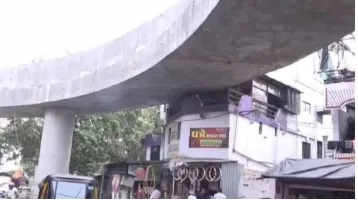Nagpur has recently gained an unusual roadside landmark at Ashok Square — a flyover rotary that nearly brushes past a house balcony, creating a surreal and viral spectacle. This odd encounter between infrastructure and residential space is part of the Indora–Dighori flyover project, but it has quickly become a source of public amusement, concern, and now a heated blame game between the National Highways Authority of India (NHAI) and the Nagpur Municipal Corporation (NMC).
The NHAI was prompt to respond to the public outcry, issuing a clarification that the house in question is an illegal encroachment constructed without any sanctioned plan. According to NHAI, the issue has already been referred to the NMC for appropriate action. The authority emphasized that the flyover rotary itself is safe and built according to the approved design. They pointed out that there is a 1.5-metre gap between the structure and the property boundary, but the homeowner had allegedly extended the balcony illegally beyond the property line. “
The protruding portion will be demolished shortly,” the NHAI asserted firmly.However, the narrative took a sharp turn when Lokmat Times spoke with Ganesh Rathod, Assistant Commissioner of NMC’s Gandhibagh Zone. Rathod revealed that the NHAI had not consulted the civic body during the Detailed Project Report (DPR) stage. “We were never informed that this house would be affected by the project. We only learned about it after the rotary slab was completed,” he said. He also clarified that demolition is not imminent since the house has not yet been officially declared an encroachment.
Adding complexity, the property is located on slum-notified land. The owner has been asked to prove residence prior to 2011 through documents like voter ID, ration card, tax receipts, and a slum certificate. If the owner is found eligible, then NMC must provide compensation before any removal can take place.For now, Nagpur residents continue to watch the flyover and balcony standoff unfold—a concrete reminder of flawed urban planning and the consequences of poor coordination between agencies.
